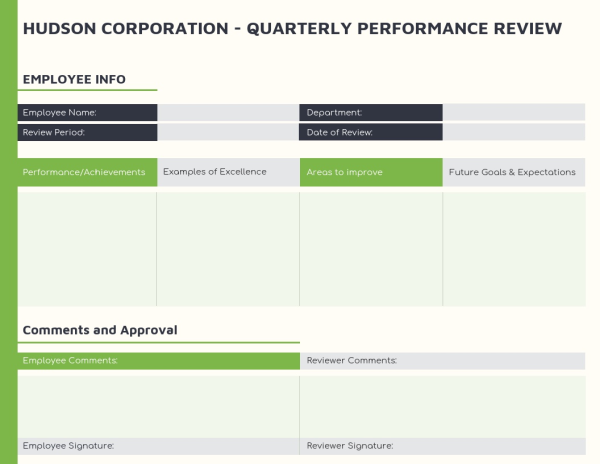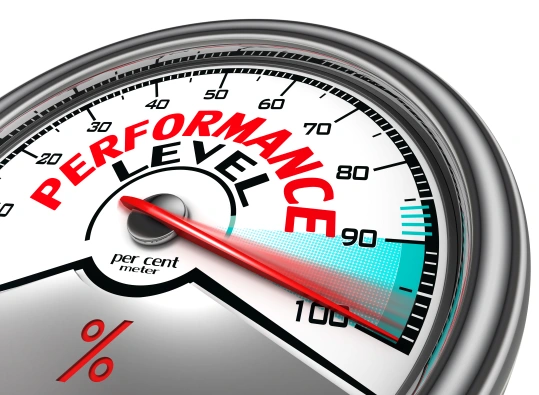Sales is a fast-paced environment, leaving sales representatives and managers with little or no time to look back at their performance and assess where they stand.
From prospecting and creating pitches to making proposals, following up and closing deals -- it’s a never-ending cycle focused on meeting target after target.
In such scenarios, quarterly or annual performance reviews serve as a reminder to pause, reflect, and align with the company’s goals.
In fact, companies that set performance goals quarterly generate 31% greater returns from their performance process than those that do it annually, according to a Forbes article.
Let’s take a look at five best practices to conduct sales performance reviews that boost team morale and productivity:
1. Use a performance review template
Some companies don’t have clear and specific performance criteria before reviews begin, according to a McKinsey study, and that’s alarming to note.
Not having clear performance criteria in place leaves room for ambiguity and bias because there is no level playing field for evaluating your sales professionals.
To avoid such a scenario, it’s vital to establish a performance review rubric and communicate the same to employees during the onboarding process so that they’re aware of what is expected of them.
Create a performance review template, taking into account their job functions and measurable goals. The purpose of using a template is to perform an unbiased evaluation while assessing the performance metrics that matter.
Here’s a performance review example that includes achievements and areas of improvement. It also has a section on core values that can be customized to include key performance indicators that are important for your company.

Source: Venngage
2. Evaluate their sales process
Many sales managers treat performance reviews like a blame game, but that never works. It just ends up demotivating the team and hurting morale.
What’s more, this gets trickier in a field like sales that is so driven by the numbers game. It’s convenient to evaluate performance on the basis of the numbers achieved but how effective is it?
Sales performance reviews should go beyond checking whether your representatives have achieved their targets. It’s equally important to evaluate their sales strategies and assess elements that lead to the final outcome as well.
Here are a few key performance indicators you should measure while managing your sales team:
- New leads or opportunities
- Upsell or cross-sell rates
- Sales cycle length
- Meeting acceptance rates
- Positive vs. negative reply rates
- Client acquisition rates
- The average cost per lead
Apart from these KPIs, have a discussion with them on their sales process and how they take leads down the sales funnel. This will further help you identify strengths and areas for improvement.
3. Provide meaningful feedback
“You need to be more productive.”
That’s an example of poor feedback. All it does is point out what is wrong with the sales representative and is not useful.
As a sales leader, you need to ensure you deliver effective feedback that includes the positives and conveys areas of improvement while being encouraging.
It’s a good idea to start with positive aspects and proceed to constructive criticism. Be sure to also share examples to back your feedback up and offer useful suggestions to improve.
For instance, if you think one of your team members can improve their cold calling approach, tell them why you feel so and educate them on how they can improve by sharing tips on how to captivate the prospect’s attention or overcome sales objections during cold calls.
4. Address challenges and roadblocks
Performance reviews are not a one-sided conversation. Apart from assessing performance, you need to also use this opportunity to discuss their challenges. As a sales leader, it’s your responsibility to ensure your team is equipped with everything they need to succeed. Use this opportunity to understand if they’re facing any roadblocks that are preventing them from meeting their sales objectives effectively. It can range from insufficient research or data and content assets to inefficient CRM software.
So, make time for addressing their challenges in the performance review meeting agenda. This collaborative approach assures them that you’re all working as a team toward a common goal.
5. Create a detailed action plan
From outlining strengths and weaknesses to identifying gaps and areas for improvement, you’ve done it all, but what next?
Performance reviews need to be action-oriented. It’s important to end the discussion with a detailed action plan that sets expectations and goals for the next quarter (or a specific time period) while stating what the sales representative needs to do to meet those goals.
Working around an action plan makes it easier for both parties to keep track of performances and follow up on feedback periodically.
Here’s an example of a performance review template that dedicates a space to “future goals and expectations”, taking into account the action plan.

Source: Venngage
The takeaway
Sales is a stressful job. As a sales leader, you can either add to the pressure (and have your team crumble) or establish a conducive feedback culture that promotes growth.
The key is to conduct structured sales performance reviews with the right assessment tools to drive professional growth and set up your sales team for success.
Simki Dutta is a content marketer at Venngage, a free infographic maker and design platform. When she's not working, she can be found refreshing her Twitter feed and binge-watching Netflix shows. Find her on Twitter and LinkedIn.


